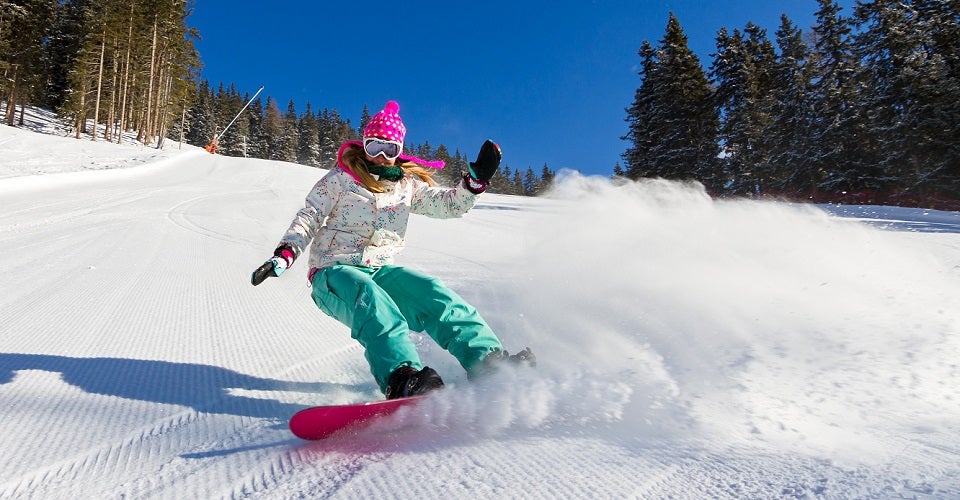
Our Editors independently research, test, and rate what we feel are the best products. We use affiliate links and may receive a small commission on purchases.
While fashion invariably changes every time the earth makes a revolution, good winter clothing choices don’t always follow the same pattern. Today we’re going to look at women’s snowboard jackets.
As a full-time alpine instructor, I spent over 100 days a season on snow in Utah. To help you choose a snowboard jacket, I’ll be lending some of that experience over to you!
In this article, we’ll cover how you can pick out a top women’s snowboard jacket from junk. I’ll give you some practical tips on what to look for and, if you’re interested, some technical details about winter performance jackets.
We’re also going to recommend some great quality snowboard jackets you can choose from on the market today!
Best Snowboarding Jackets For Women
| Burton Women’s Jet Set Jacket | Arc’teryx Sentinel AR Jacket – Women’s | 686 Women’s Athena Waterproof Snowboard Jacket | |
|---|---|---|---|
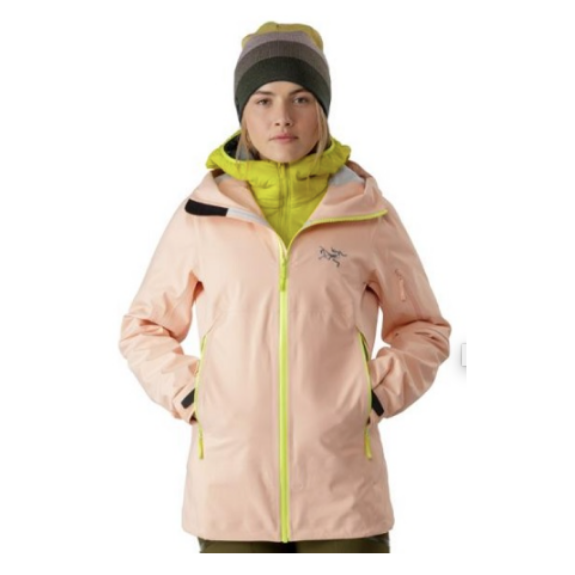 | |||
| Vents: | Yes | Yes | No |
| Waterproof: | Yes / 10,000MM | GORE-TEX | Yes / 10,000MM |
| Powder Skirt: | Yes | Yes | No |
| Insulation: | Thermolite | None | Yes |
| REI |
For more of my snowboarding recommendations, have a look through these popular Outside Pursuits guide links: Snowboard Pants, Snowboard Gloves, Snowboard Boots.
Quick Answer: The 7 Best Rated Women’s Snowboard Jackets
- Burton Women’s Jet Set Snowboard Jacket
- Arc’teryx Women’s Sentinel AR Snowboarding Jacket
- 686 Women’s Athena Waterproof Snowboard Jacket
- Volcom Mission Insulated Snowboard Jacket Womens
- Columbia Womens Whirlibird Iv Interchange Jacket
- Patagonia Snowbelle 3-in-1 Women’s Snowboard Jacket
- The North Face Women’s Osito Triclimate Jacket
Our reviews of the top rated women’s snowboarding jackets with our comparison table and buyers guide will help you choose the right one.
Women’s Snowboard Jacket Reviews
#1 Burton Women’s Jet Set Jacket
- Vents: Yes
- Waterproof: Yes / 10,000MM
- Powder Skirt: Yes
- Insulation: Thermolite
It’s impossible to explore the world of snowboarding without getting hit over the head by Burton marketing. They’ve been around a while and their gear is pretty well tested – that’s why the Jet Set makes our list.
Technically speaking, this jacket meets all of the criteria. It’s waterproof, made from 2 layers of Dryride fabric (Burton brand). There are underarm zips for temperature management. Additionally, you get the benefits of a powder skirt that is also removable if you don’t want it.
Maybe the only complaint I have about this jacket, and it’s not much, is that the hood can’t be removed. This is irritating when you’re wearing a helmet all day and your hood slowly fills with falling snow before then dumping all that snow down your back when you least expect it.
It’s worth mentioning that this jacket is also available in about 2 dozen different colors and patterns!
Best mid-season women’s snowboard jacket available in a wide variety of colors.
#2 Arc’teryx Sentinel AR Jacket – Women’s
- Vents: Yes
- Waterproof: GORE-TEX
- Powder Skirt: Yes
- Insulation: None
Want a bomber jacket with modern styling and pretty much the best all around stats in the game? Here we go!
Arc’teryx does an awesome job! Their attention to detail pays off in the quality of the seam sealing, fit, and zippers. Just keep in mind that you’ll need to stack layers under this garment on the mountain. It’s a non-insulated shell jacket which is perfect if you’re like me and prefer to get your insulation from your layers instead.
All that said, you’d better be ready to pay through the nose. Arc’teryx products, in general, tend to really tip the scales on the expensive side of the spectrum so make sure your budget can justify it.
On a technical note, you will get vent zippers (great!) but you won’t be able to remove your hood. I would rate the Sentinel the best women’s snowboarding shell jacket.
#3 686 Women’s Athena Waterproof Snowboard Jacket
- Vents: No
- Waterproof: Yes / 10,000MM
- Powder Skirt: No
- Insulation: Yes
Affordable, good looking, and ready to hit the mountain. What else do you need? At a price that is hard to argue with this snowboard jacket deserves a look.
A couple notes upfront before we get too deep. This jacket is quite long so if you have a shorter torso you may find that it actually comes down far enough to impede leg movement.
Now that’s out of the way let’s check out the technical stuff. While the jacket is insulated, the manufacturer didn’t readily specify any info about the insulation. It is waterproof and breathable using infiDRY fabric. You won’t find a powder skirt inside, but there is a pant-jacket attachment available that you can pair up with 686 pants to keep the snow out.
There are 5 different styles and the jacket is available in 5 sizes to fit most frames. Best for a budget women’s snowboard jacket that can get you up and running!
#4 Volcom Mission Insulated Snowboard Jacket Womens
- Vents: Yes
- Waterproof: WPB
- Powder Skirt: Yes
- Insulation: Minimal
Insulated, hooded, fur collared jackets are nothing if not warm. Volcom, another giant name in snowboarding, brings us this hyper-warm jacket that will definitely keep you toasty on the slopes.
I will say I’m glad they took a low-loft insulation approach on this jacket. That means, while the jacket is definitely warm, it’s cool enough for all-season boarding and you can stack up layers when the weather really turns nasty.
There is a powder skirt on this jacket. If you prefer, however, you can just ditch that in favor of the Zip Tech Jacket to Pant Interface. Connect your jacket straight to your Volcom pants to keep your snow and cold both!
This is another very long jacket – a popular snowboarding trend – so just make sure that doesn’t interfere with your athletic ability on snow.
Best for pairing up with Volcom pants for a seamless integrated riding system.
#5 Columbia Women’s Whirlibird IV Interchange Jacket
- Vents: Yes
- Waterproof: WPB
- Powder Skirt: Yes
- Insulation: Omni-heat / Removable
Columbia gear almost always makes it onto my lists. Why? Because they provide an immense amount of value for the price!
If you haven’t run into the “interchangeable” type of snowboard jacket let me explain it. Interchange systems have a zip-in insulated liner (this one is synthetic) that fits inside of a waterproof outer shell. You can wear the shell and liner, shell alone, or insulated jacket alone. They’re great for flexibility!
While I don’t like that the hood is permanently attached, there’s still plenty to love. Columbia uses their Omni-heat reflective dots to bounce back radiated body heat for increased warmth in a small package.
I also have to say that I love the shorter athletic cut on this jacket – rather than the longer baggy style but that’s just me! The best women’s snowboarding jacket under $200.
#6 Patagonia Snowbelle 3-in-1 Women’s Snowboard Jacket
- Vents: Yes
- Waterproof: H2No / WPB
- Powder Skirt: Yes
- Insulation: 60g Thermogreen® / Removable
While some companies might focus on price for value, Patagonia is certainly not among them. Patagonia’s quality and products, however, is very hard to argue with!
Of all the jackets we’ve checked out so far, this is the first to incorporate a Recco reflector. If you remember, these little gadgets get sewn into the garment and help to make you detectable by search teams using Recco technology (increasingly popular).
Finally, we also get a jacket with a removable hood. If you’re like me and this is important to you then pay attention!
Additionally, the Snowbelle jacket also has an interchangeable 3-1 layer system. On top of all that it also has vent zips. Is there anything not to like?
No matter what time of the season you’re riding – with or without a helmet – this jacket can be adjusted to keep up!
Best all around snowboarding women’s jacket for changing weather and changing styles.
#7 The North Face Women’s Osito Triclimate Jacket
- Vents: Yes
- Waterproof: WPB
- Powder Skirt: Yes
- Insulation: Removable
No one will argue that The North Face is new to the game. These guys and gals know how to make outdoor gear so let’s check out their snowboard jacket.
Comparable to the other 3-layer jackets on our list, this one is made to keep up with whatever you’re doing. On the outside you’ll find a waterproof breathable shell. Underneath is a removable fleece jacket made from 300-weight (very thick) fleece.
I should mention that the hood is removable, thankfully!
Overall if you prefer the cut and fit of the Osito it might take precedence over the Snowbelle. If all else is equal, however, I would probably rank the Snowbelle slightly higher among 3-part snowboard jackets.
If you are looking for the warmest womens snowboarding jacket, look no further!
Women’s Snowboard Jacket Comparison Table
| Women’s Snowboard Jacket | Vents | Waterproof | Powder Skirt | Insulation | |
|---|---|---|---|---|---|
| Burton Women's Jet Set Jacket | Yes | Yes / 10,000MM | Yes | Thermolite | |
| Arc'teryx Sentinel AR Jacket - Women's | 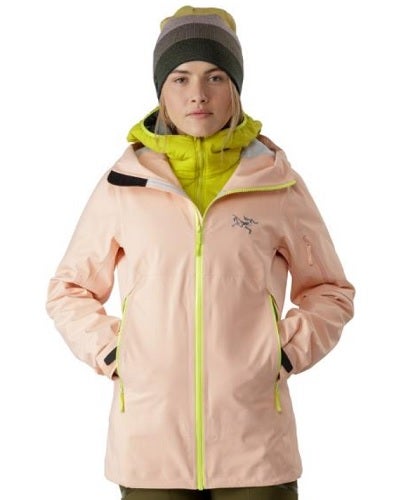 | Yes | GORE-TEX | Yes | None |
| 686 Women's Athena Waterproof Snowboard Jacket | No | Yes / 10,000MM | No | Yes | |
| Volcom Mission Insulated Snowboard Jacket Womens | Yes | WPB | Yes | Minimal | |
| Columbia Womens Whirlibird IV Interchange Jacket | Yes | WPB | Yes | Omni-heat / Removable | |
| Patagonia Snowbelle 3-in-1 Women's Snowboard Jacket | 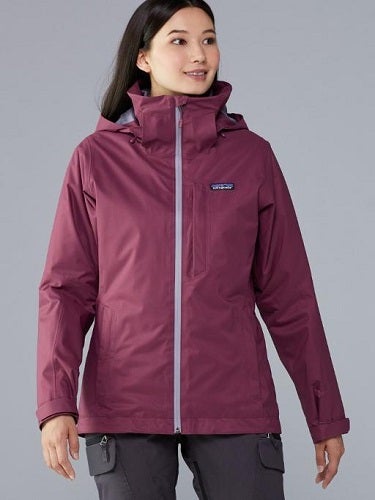 | Yes | H2No / WPB | Yes | 60g Thermogreen® / Removable |
| The North Face Women's Osito Triclimate Jacket | Yes | WPB | Yes | Removable |
Author’s Expertise / Why You Should Trust Our Reviews
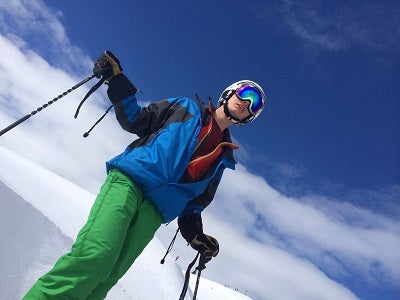
I started writing online for my own outdoor sports blog in 2010. Right out of the gate I landed opportunities to test gear for Road ID, Hydrapak, Wolverine, Helle Knives, Pearl Izumi, and GU Energy. Those were the days when growing a no-name blog was easy. Today niche blogging is a different story.
In 2012 I left Central Wyoming College with a degree in Outdoor Education and Leadership. Soon after, I was on a month-long expedition with the National Outdoor Leadership School’s Outdoor Educator Course which helps would-be outdoor guides ascend from “aspiring” to “inspiring”.
Between here and there I’ve participated in and spoken at length about outdoor pro-deal programs for companies like Patagonia, Smith Optics, Giro, Therm-a-Rest, Platypus, MSR, Columbia, and many more. I still work closely with tons of outdoor gear companies to review and analyze products. If you have a product opportunity you’d like to discuss, please review my guidelines and contact me here.
After several seasons of guiding backpacking trips and working as a certified Alpine Ski Instructor at Deer Valley Resort in Park City, UT for several seasons, I had to move on. As any educator will tell you – teaching doesn’t pay the bills very well.
In 2016 I began building my freelance writing career as readers and other bloggers reached out to me for help with technical outdoor sports content strategy for online businesses. Within weeks I was overloaded with requests for freelance writing and my new career blossomed.
2018 saw the launch of Hike With Less, my ultralight backpacking partnership program with Dustin Walker.
How to Choose the Best Women’s Snowboarding Jacket
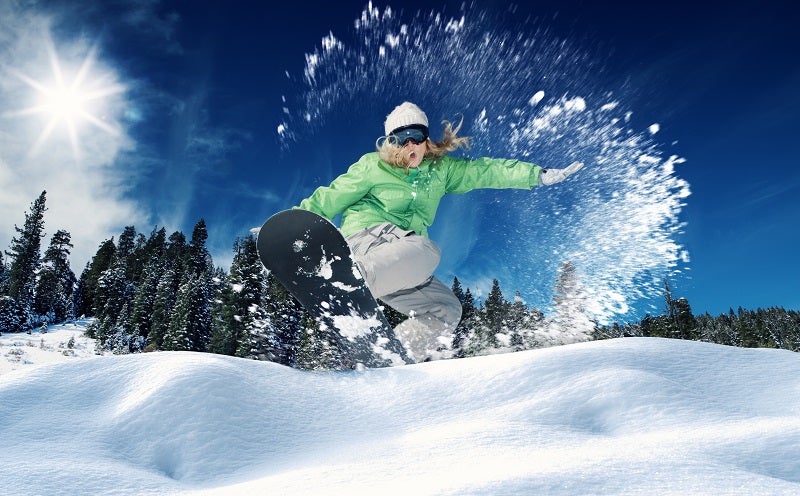
Waterproofness
In the world of winter jackets, you’ll need two things: warmth, and water resistance. Waterproofness comes in a ton of flavors and varieties in modern snowboard jackets so let’s break those down.
Waterproof means a garment will not allow the passage of precipitation.
Water-resistant means a garment will maybe help slow down the passage of precipitation.
Of course, these are pretty self-explanatory. However, what might trip up a lot of people is that manufacturers often hide or mask these words to make cheap products seem better. Be sure that if you want a waterproof snowboard jacket you see the manufacturer clearly specify the level of waterproofness on the garment.
Among waterproof snowboard jackets, you can basically break them down into two further groups. We have waterproof (basic) and waterproof breathable (WPB).
Waterproof garments allow zero passage of liquid or water vapor either into or out of the jacket. Waterproof breathable jackets, on the other hand, block water coming in but allow some water vapor to escape.
While waterproof breathable technology continues to improve year after year one thing stays the same. WPB garments are always more expensive than the equivalent basic waterproof jacket.
Waterproof Breathable
If you have the budget for it, paying more to buy a WPB snowboard jacket might help you. While there’s no doubt that by the numbers WPB garments do in fact allow water vapor to escape, their empirical effectiveness remains subjective.
What I mean is that many people (myself included) find that WPB garments just don’t allow vapor to escape quickly enough to justify their effectiveness. On the mountain (unless it’s raining) I prefer to simply unzip my jacket or use vent zips for airflow rather than rely on the breathability of my jacket.
That’s not to say WPB is bad. You may love it – many people swear by it!
If you do choose to go WPB, don’t be afraid of “off brands”. While at one time Gore-Tex was the king of WPB fabrics, most manufacturers now have proprietary in-house brands of WPB fabrics that are just as good or better (and often cheaper). All that to say – brand loyalty need not apply in most cases!
If you want to get into the nitty-gritty details of which WPB fabrics are “the best” then I would start with this nice write-up by Stacia over at The Trek.
Seam Sealing
Waterproof fabric by itself has become affordable and easy to make garments from. One drawback of garment making from waterproof fabric, however, is that the sewing machine used for assembly riddles the fabric with thousands of not-so-waterproof holes.
In order to undo the perforations caused in the stitching process of garment assembly a waterproof snowboard jacket needs to be seam sealed. Waterproof jackets without sealed seams, well, just aren’t waterproof at all.
This is yet another area where cheap manufacturers may try to hide their subpar quality. Be sure that if you don’t trust the manufacturer, double-check that the garment specifically states that it is seam sealed (also called taped).
Insulation and Warmth
Snowboard jackets need to provide some warmth. How much warmth? What type of insulation is used to provide that warmth? Let’s find out.
How much insulation you need depends on two factors: outside temperature and inside temperature. While it’s typically cold when snowboarding, late-season (spring) temps on the mountain can often soar unexpectedly into the 30’s and 40’s. Wearing a jacket with too much insulation in these situations will lead to a sweat-drenched day on the slopes.
Additionally, your internal temperature plays a factor in snowboard jacket selection. If you’re going slow, teaching a beginner friend and it’s sub-zero out you may need extra insulation. Conversely, however, if you’re pushing your limits and boarding hard you may work up a sweat quickly in even the coldest temps.
Types of Insulation
Most snowboard jackets will have some level of insulation. If yours doesn’t this is known as a “shell” jacket – a waterproof, windproof jacket without insulation. In this case, you’ll want to wear some form of insulating layers underneath it (this is my preference).
Whether your insulation is a standalone layer or integrated into your snowboard jacket you’ll encounter essentially two types: synthetic and down.
Down insulation is made from animals – ducks and geese. Down is absurdly lightweight for its performance. We won’t go deep into the details of how and why down is higher-performing insulation than most (if not all) synthetics. Instead, just suffice it to say that down is lightweight, highly insulative, and all-around awesome.
Down comes with drawbacks, however. It’s expensive for starters. Also, if down insulation does happen to get wet the ability to insulate deteriorates quickly (don’t worry once it dries it will be fine). Additionally, down insulation is a real pain to wash if you need to clean it.
If down doesn’t sound like your bag synthetic insulation might be the ticket. Man-made synthetics come in an enormous variety. However, there are some similarities between all of them.
Synthetic insulation, generally, doesn’t pack down as well as down. Typically this isn’t an issue for snowboarding, but if you want a layer to keep in your backpack then packability may be a priority.
Synthetic insulation is generally a bit heavier apples-to-apples than down. Additionally, if your jacket does get soaked then synthetic insulation will do a better job of keeping you warm when wet.
For snowboarding, I think down insulation makes a lot of sense during the cold months. When precipitation is certain to be solid – down can’t really go wrong. When it gets to springtime and you’re snowboarding on slush you might be surprised how common it can be to get rained on. If that’s the case then there’s a case to be made for synthetic insulation.
Vents and Zips
As I mentioned earlier in the “waterproof” section sometimes zips and vents are some of the best features on a snowboard jacket.
When you get on your board in the morning and the sun hasn’t crested the mountain you might be cold. After a few laps down some runs and the sun has started to warm things up you’ll probably be thinking about ditching your jacket.
Instead of changing layers, a lot of time you can use zippers or vents to adjust on the fly.
I highly recommend looking for pit zips (armpit zips). These are zippered vents under the arms of your jacket which can be opened and closed to help regular temperature. Pit zips are the best for quick adjustments!
Pit zips aren’t on all garments. If they’re not available, look for other vents. Zips can sometimes be found on the chest, back, or sides of your snowboard jacket. These are all helpful and valid.
If all else fails and you can’t find any vent zips then don’t forget you’ve got the main jacket zipper. Use this zipper to adjust for temperature on the fly.
Jacket Hoods
Snowboard jackets have three hood styles: hooded, hoodless, and removable.
To keep things simple I think one factor plays the most in your decision about hood or no hood: are you or are you not wearing a helmet?
If you wear a helmet you’ll want either no hood or a removable hood. There are few if any situations in inbound snowboarding for the overwhelming majority of people where you need (or want) a hood over your helmet. For that reason, it’s usually best to just avoid the hood altogether.
If you don’t wear a helmet then I highly recommend a hood. It will help keep you warm and shed precipitation. In the unfortunate eventuality that you take a digger, it may provide just a touch of noggin protection too.
Powder Skirt
Powder skirts are elastic cinches that go around your hips inside of a snowboard jacket. If you take a spill or make an awesome run through deep powder you’ll be amazed how fast a pile of cold snow can get shoved up under your jacket (if you haven’t already experienced this).
Powder skirts on snowboard jackets are really pretty sweet. However, if you only ever board on gentle groomed runs and you rarely find yourself taking a spill… they might not really be a necessity.
Keep in mind, however, that you can have a powder skirt and not use it all the time. If you forget to button it closed or just don’t want to… then skip it! But at least it’s there.
Recco Reflector
More and more popular these days are Recco reflectors. These little reflective strips can be sewn into garments and help make you more detectable to special search equipment.
There is definitely some controversy about the empirical effectiveness of Recco reflectors. However, by the numbers, a Recco reflector definitely does make you more discoverable by certain search technologies.
Fashion Choices
In my world, on the mountain, performance always beats fashion. However, looking good is part of feeling good!
I don’t have much to say about fashion since it’s largely subjective. What I will say, though, is to be careful of the tight, fitted modern cuts that are trending on a lot of today’s outdoor gear.
As long as your jacket doesn’t impede your movement then you’re good to go. Be sure you can fully move your arms without restriction. Check your range of motion in all directions to be sure that your garment doesn’t restrict you too much!
FAQs For Snowboard Jackets
Q: Is there a difference between ski and snowboard jackets?
A: Fundamentally, no there is not a difference. Or at least, there doesn’t need to be a difference.
Between skiing and snowboarding the only difference that makes a meaningful impact on clothing is movement. Because skiers have two sticks, their legs move more independently. This means deeper leg flexing, more twisting at the hips, and other differences in motor control.
Snowboarding, however, tends to have less independent leg movement. That means you can get away with lower, baggier, more restrictive clothing when snowboarding.
This is one of the reasons that snowboard jackets tend to be baggy and long. As long as your jacket doesn’t impede necessary movement then any difference should just be personal choice.
Q: Should snowboard jackets be baggy?
A: Snowboard jackets should not be baggy if that bagginess impedes your ability to control yourself or your board. Otherwise, the bagginess is just a personal choice.
So long as your jacket doesn’t detract from your ability to snowboard then choose whatever level of bagginess suits your needs or your style.
Q: What should you not wear snowboarding?
A: Leaving stuff at home that can get you hurt or detract from your ability to board well. If that’s the case – leave it at home!
A lot of what you should not wear comes down to chairlift safety.
Keep strings, tags, and dangling shock cord adjusters under control. The last thing you want to do is get your glove straps stuck in a corner of the chairlift safety bar and then get dragged around the lift station by your wrist. Be safe out there.
Another thing to leave behind is your backpack when you’re using chairlifts. Backpacks often force you to sit forward on the lift. This can make it all too easy to slip and fall off the chair when you’re distracted.
Wearing too much clothing is also a no-no. Over layering will lead to overheating, sweating, and having a bad time on the mountain. Layers are good, but if you overdo it then it can be really difficult to strip layers off throughout the day.
Q: What is a snowboarding shell jacket?
A: Shell jackets are non-insulated waterproof jackets. These jackets are made to be layered over the top of insulation or other undergarments.
Using a shell jacket is an outstanding way to adapt to weather. I love using a shell jacket so that I can pick what type and how much insulation to wear on any given day. This is a better system for me than putting on a jacket with a fixed amount of insulation built in that can’t be changed.
Shell jackets should be made from durable, high quality nylon or polyester. They also need to be well waterproofed so double check for good seam sealing.
Q: What does 10k mean on snowboard jackets?
A: Generally 10k is referring to the level of waterproofing on your jacket.
Today’s most common waterproofing test is called a static-column or head test. In this test water is literally stacked in a tube on top of the fabric in question. One enough water is stacked up it will eventually leak through.
The height of water stacked on a fabric before it leaks is measured and then reported. Usually 10,000 mm of “stacked water” is considered to be the acceptable level of waterproofing on most outdoor gear.
Thus you’ll often find the number 10k, or 10,000, represented in many waterproof clothing ratings. Of course, this number could also be 5k, 15k, 30k or any other number that is a result of the static column test for the waterproof layer of the jacket in question.
To learn more about the static column test check out this article.
Conclusion
At the end of the day snowboard jackets need to be able to keep up with the demands you place on them. Whether you wear a helmet, prefer to ride with your jacket hood up, or any other preference. It’s all about what you want.
Women’s snowboard jackets are designed, cut, and fit for the female form and should help you be more comfortable and confident – not get in the way or hold you back. If you’re feeling warm, comfortable, and free to move then you’re sure to have a better day and better performance on your board.
I always encourage people to avoid getting caught up in the big flashy name brands. Find a jacket that has the quality, look, and performance you need and don’t worry too much about which name brand is on the logo.
How We Researched
To come up with the top women’s snowboarding jackets, we researched a variety of sources for reviews such as REI, Backcountry, Moosejaw, EVO along with our own personal experience.
We also consulted online magazines for product research and reviews to get as much unbiased information as we could. To help weed out fake reviews we used Fakespot.com to make sure we only looked at genuine reviews.
With so much quality gear available, we had to narrow it down based on what we felt were the best options were for the price. The author, Casey Fiedler was a full-time ski instructor for Park City and The Canyons in Utah.
To help narrow down the selection he used his personal experience along with recommendations from fellow ski instructors.
After extensive research, we came up with our list to help you choose the right one for you.

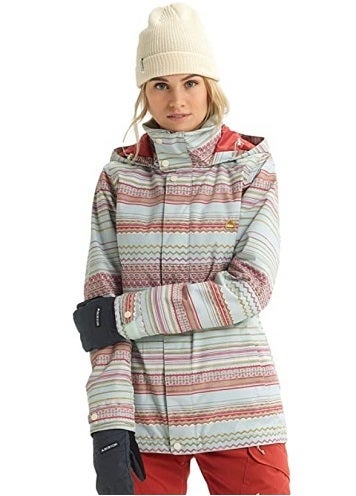
Thank you for the removeable hood recommendations! I rarely ride in weather below 25* and even then I prefer to use a neck gaiter & shut the vents on my helmet. I’m so frustrated with snow fillling up my “floppy never gets used hood” even if it is helmet compatible. I’ve been all over the USA west coast and into WY. I’ve never needed or wanted a hood when riding. I hate them so much I’m taking sone favorite coats to a professional tailor to have the hoods removed.
Your welcome Kagie, personally I thing hoods are useless for snowboarding/skiing. Hope you are enjoying the season!